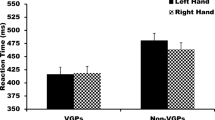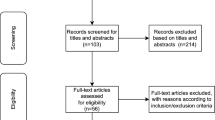Abstract
Over the past several decades, there has been much interest regarding the effects of video game play. Research has evaluated the behavioral, cognitive, and psychological effects of video game play, and found individuals who play games using complex and dynamic game settings and require focused attention with quick responses, such as action video games, demonstrate improved cognitive performance. Action video game training has also yielded rehabilitation efficacy for a myriad of patients, such as stroke patients and individuals with vestibular and balance deficits. Recently, new technology platforms have been developed such as mixed reality (MR); however, little to no research has been conducted examining the effects of advanced technology platforms. The purpose of the current study was to explore whether MR game training improved visuo-motor reaction time and balance performances. Fourteen participants (11 male; 18–50 years of age) underwent baseline and post-intervention assessments, and then complete 8 h of MR action game training. Visuo-motor reaction times were obtained via computerized Automated Neurocognitive Assessment Metric testing and balance measures were obtained via Sensory Organizational Testing. Baseline and post-intervention comparisons were analyzed using Wilcoxon signed-rank tests. Baseline and post-intervention visuo-motor reaction time and balance comparisons revealed that MR game training yielded significant reaction time improvements (p < 0.05) and vestibular performances (p < 0.05) following game training. Our results suggest visuo-motor reaction time and balance performances were significantly improved following of 8 h of action MR game training.


Similar content being viewed by others
References
Alsalaheen BA, Whitney SL, Mucha A, Morris LO, Furman JM, Sparto PJ (2013) Exercise prescription patterns in patients treated with vestibular rehabilitation after concussion. Physiother Res Int 18:100–108
Anguera JA, Boccanfuso J, Rintoul JL, Al-Hashimi O, Faraji F, Janowich J, Kong E, Larraburo Y, Rolle C, Jonhston E, Gazzaley A (2013) Video game training enhances cognitive control in older adults. Nature 501:97–103
Bavelier D, Green CS, Pouget A, Schrater P (2012) Brain plasticity through the life span: learning to learn and action video games. Annu Rev Neurosci 35:391–416
Bialystok E (2006) Effect of bilingualism and computer video game experience on the simon task. Can J Exp Psychol 60:68–79
Castel AD, Pratt J, Drummond E (2005) The effects of action video game experience on the time course of inhibition of return and the efficiency of visual search. Acta Psychol 119(2):217–230
Cernich A, Reeves D, Sun W, Bleiberg J (2006) Automated neuropsychological assessment metrics sports medicine battery. Arch Clin Neuropsychol 22S:S101–S114
Chandra S, Sharma G, Salam AA, Jha D, Mittal AP (2016) Playing action video games a key to cognitive enhancement. Procedia Comput Sci 84:115–122
Chanpimol S, Seamon B, Hernandez H, Harris-Love M, Blackman MR (2017) Using xbox kinect motion capture technology to improve clinical rehabilitation outcomes for balance and cardiovascular health in an individual with chronic TBI. Arch Physiother 7(6):1–11
Clark K, Fleck, Mitroff SR (2011) Enhanced change detection performance reveals improved strategy use in avid action video game players. Acta Psychol (Amst) 136:67–72
Cole WR, Arrieux JP, Schwab K, Ivins BJ, Qahu FM, Lewis SC (2013) Test–retest reliability of four computerized neurocognitive assessment tools in an active duty military population. Arch Clin Neuropsychol 28(7):732–742
Cook MR, Graham C, Sastre A et al (2002) Physiological and performance effects of pyridostigmine bromide in healthy volunteers: a dose-response study. Psychopharmacology 162(2):186–192. https://doi.org/10.1007/s00213-002-1074-6
Cuthbert JP, Staniszewski K, Hays K, Gerber D, Natale A, O’Dell D (2014) Virtual reality-based therapy for the treatment of balance deficits in patients receiving impatient rehabilitation for traumatic brain injury. Brain Inj 28(2):181–188
Franceschini S, Gori S, Ruffino M, Viola S, Molteni M, Facoetti A (2013) Action video games make dyslexic children read better. Curr Biol 23:462–466
Green CS, Bavelier D (2003) Action video game modifies visual selective attention. Nature 423:534–537
Green CS, Bavelier D (2012) Learning, attentional control, and action video games. Curr Biol 22:R197–R206
Green SC, Bavelier D (2015) Action video game training for cognitive enhancement. Curr Opin Behav Sci 4:103–108
Green CS, Pouget A, Bavelier D (2010) A general mechanism for learning with action video games: improved probabilistic inference. Curr Biol 20:1573–15792
Herdman SJ, Clendaniel RA (eds) (2014) Vestibular rehabilitation, 4th edn. F.A. Davis Co., Philadelphia
Li RW, Ngo C, Nguyen J, Levi DM (2011) Video-game play induces plasticity in the visual system of adults with amblyopia. PLoS Biol 9(8):el001135–e1001146
Lo Bue Estes C, Willer B, Burton H, Leddy JJ, Widing GE, Horvath PJ (2008) Short-term exercise to exhaustion and its effects on cognitive function in young women. Percept Motor Skills 107(3):933–945
McDermott AF, Bavelier D, Green CS (2014) Memory abilities in action video game players. Comput Hum Behav 34:69–78
Micarelli A, Viziano A, Augimeri I, Micarelli D, Alessandrini M (2017) Three-dimensional head mounted gaming task procedure maximizes effects of vestibular rehabilitation in unilateral vestibular hypofunction: a randomized controlled pilot trial. Int J Rehabilit Res 40:325–332
Microsoft HoloLens. https://www.microsoft.com/en-us/p/roboraid/9nblggh5fv3j?activetab=pivot%3Aoverviewtab
Microsoft Tech. https://www.microsoft.com/en-us/hololens
Nashner LM, Peters JF (1990) Dynamic posturography in the diagnosis and management of dizziness and balance disorders. Neurol Clin 8(2):331–349
Pavlou M, Lingeswaran A, Davies RA, Gresty MA, Bronstein AM (2004) Simulator based rehabilitation in refractory dizziness. J Neurol 251:983–995
Pavlou M, Quinn C, Murray K, Spyridakou C, Faldon M, Bronstein AM (2011) The effect of repeated visual motion stimuli on visual dependence and postural control in normal subjects. Gait Posture 33:113–118
Phillips JS, Fitzgerald J, Phillis D, Underwood A, Nunney I, Bath A (2018) Vestibular rehabilitation using video gaming in adults with dizziness: a pilot study. J Laryngol Otol 132:202–206
Reeves DL, Winter KP, Bleiberg J, Kane RL (2007) ANAM® genogram: historical perspectives, description, and current endeavors. Achiev Clin Neuropsychol 22S:S15–S37
Shumway-Cook A (2007) Assessment and management of the patient with traumatic brain injury and vestibular dysfunction. In: Herdman SJ (ed) Vestibular rehabilitation. F.A. Davis Company, Philadelphia, pp 444–457
Strobach T, Frensch PA, Schubert T (2012) Video game practice optimizes executive control skills in dual-task and task switching situations. Acta Psychol 140(1):13–24
Trueblood PR, Rivera M, Lopez C, Bently C, Wubenhort N (2018) Age-based normative data for a computerized dynamic posturography system that uses a virtual visual surround environment. Acta Oto-Laryngol 138(7):597–602. https://doi.org/10.1080/00016489.2018.1429653
Wrisley DM, Stephens MJ, Mosley S, Wojnowski A, Duffy J, Burkard R (2007) Learning effects of repetitive administrations of the sensory organization test in healthy adults. Archiv Phys Med Rehabilit 88:1049–1054
Acknowledgements
The authors would like to thank Valerie Martin, DPT, for her helpful discussion regarding clinical vestibular rehabilitation.
Author information
Authors and Affiliations
Corresponding author
Ethics declarations
Conflict of interest
The authors declare that they have no conflict of interest.
Additional information
Publisher's Note
Springer Nature remains neutral with regard to jurisdictional claims in published maps and institutional affiliations.
Rights and permissions
About this article
Cite this article
Glueck, A.C., Han, D.Y. Improvement potentials in balance and visuo-motor reaction time after mixed reality action game play: a pilot study. Virtual Reality 24, 223–229 (2020). https://doi.org/10.1007/s10055-019-00392-y
Received:
Accepted:
Published:
Issue Date:
DOI: https://doi.org/10.1007/s10055-019-00392-y




